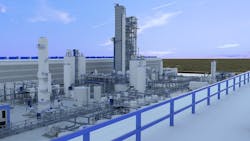A bit more than three years ago, in February 2021, I wrote here about Direct Air Capture (DAC) as an emerging negative-emissions technology (NET) and briefly mentioned several DAC developers.
At that time, one of them, Swiss-based Climeworks, already had claimed to have 14 DAC facilities, including the world’s first commercial facility. In a follow-up article in July 2022, I noted that Climeworks had broken ground in Iceland on Mammoth, its newest and largest DAC facility to date. According to the developer then, when operational, Mammoth would remove 36,000 tons per year of CO2. That would be nine times the capability of what was then the world’s largest facility, Orca, which removes 4,000 tons of CO2 per year.
After demonstrating the success of Orca, Climeworks was able to raise $650 million for the development of Mammoth, and the company expressed plans to expand the technology to millions of tons of capacity by 2030, and a gigaton of CO2 capture by 2050. Its process involves collector containers arranged around a central processing assembly, and the energy to operate it is geothermal. Because of their modular design, the collector containers can be stacked to increase capacity.
Another promising DAC developer,1PointFive, a subsidiary of Occidental's Low Carbon Ventures business (OXY) announced in 2022 its own plans to deploy 70 DAC facilities by 2035, each with an expected capacity of 1 million tons per year, eventually expanding to 135 DAC facilities. BlackRock, one of the world’s leading providers of investment, advisory and risk management solutions, announced last year that it is investing $550 million in the development of OXY’s STRATOS DAC facility which, when it becomes operational in 2025, will have the capacity to capture 500,000 tons of CO2 per year.
According to the International Energy Agency (IEA,) in order to meet its Net Zero by 2050 (NZE) Scenario, decarbonization of the energy sector and widespread deployment of clean energy technologies, while critical, are not by themselves enough. New technologies, many of which have not yet been identified, will be required, and the rate of scaling up those technologies that have already been demonstrated – like DAC – must be accelerated.
IEA pointed out in its Direct Air Capture 2022 report that “with adequate policy support”, DAC deployment could nearly reach the levels required in the NZE Scenario. However, IEA also notes in a separate report that, “even with new technologies, some residual emissions will remain because sectors such as heavy industry and aviation are harder to decarbonize, and therefore there is an unavoidable need for carbon removal.”
In other words, even if emissions targets are met, there will still be a need for CO2 removal using technology-based solutions like DAC.
####
A contributor to HPAC Engineering since 2013 and a member of its editorial advisory board, the author is a principal at Sustainable Performance Solutions LLC, a south Florida-based engineering firm focusing on energy and sustainability. He can be reached at [email protected].
